NCERT Class 11 Biology Chapter 21 Notes Neural Control And Coordination- Download PDF Notes
Did you know that humans have a complex nervous system that controls all body actions and responses? The NCERT Class 11 Biology Chapter 18 Notes Neural Control and Coordination, are written in clear language. It includes well-labeled diagrams, which make learning more effective. Neural Control and Coordination gives an idea of the human nervous system and how it plays an important role in coordinating body functions. The NCERT notes help in building a strong foundation for board and entrance exams like NEET.
This Story also Contains
- NCERT Class 11 Biology Chapter 18 Notes: Download PDF
- Class 11 Biology Chapter 18 Neural Control And Coordination Notes
- Chapter 18 Biology: Previous Year Questions and Answers
- How to Use Neural Control And Coordination Class 11 Notes Effectively?
- Advantages of Class 11 Biology Chapter 18 Neural Control And Coordination Notes
- Chapter-Wise NCERT Class 11 Notes Biology
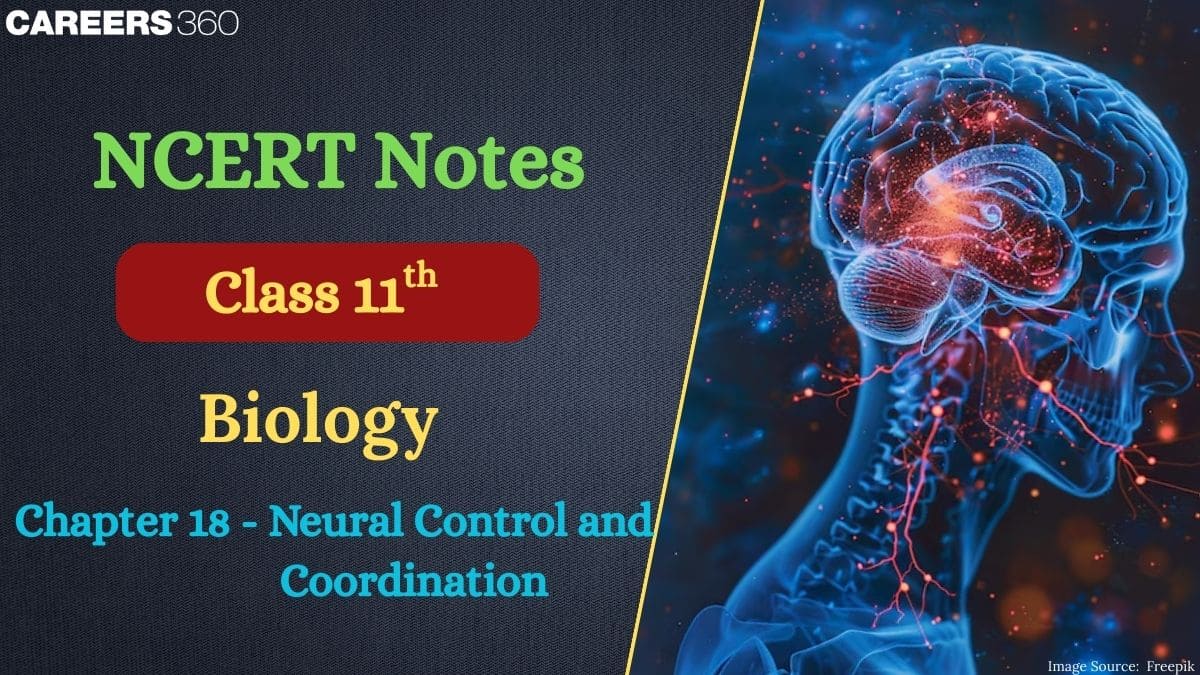
The Neural Control and Coordination Class 11 Notes include the definition of the neural system and the neuron as the structural and functional unit. Students will understand how to write answers in an exam for better marks. In addition, the NCERT Class 11 Biology Chapter 18 Notes PDF also deals with the CNS, reflex action, and reception and processing of sense. The NCERT Notes for Class 11 help students understand complex topics in a simple way and improve exam performance.
NCERT Class 11 Biology Chapter 18 Notes: Download PDF
Students preparing for school exams and for NEET can download the PDF notes for quick revision. The notes explain the structure and functions of the nervous system in a simple and clear way. The NCERT Class 11 Biology Chapter 18 Notes PDF can be accessed both online and offline. The NCERT Notes for Class 11 Biology are useful for clear revision before exams and save a lot of time.
Also, students can refer to:
Class 11 Biology Chapter 18 Neural Control And Coordination Notes
The Neural Control and Coordination chapter includes topics like the structure of neurons, reflex action, and coordination. The notes given below are a helpful resource for easy and quick revision and follow the NCERT guidelines closely. Neural Control and Coordination Class 11 Notes also explain the brain and sense organs clearly and simply.
Neural System
The neural system gives an organized network for the rapid coordination of body functions.
Coordination: Coordination among organs to support each other's functions.
Made up of neurons that perceive, receive, and conduct stimuli.
Complexity grows:
Lower vertebrates: Uncomplicated neuron network.
Insects: Brain with ganglia and neural tissues.
Vertebrates: Advanced neural system.
Human Neural System
The human nervous system is divided into two parts:
System | Components |
The brain and spinal cord processes and controls information. | |
Nerves are connected to the CNS. Includes afferent (to CNS) and efferent (from CNS) nerve fibers. |
Subdivisions of PNS:
Somatic Nervous System: Regulates voluntary muscles (e.g., skeletal muscles).
Autonomic Nervous System (ANS): Regulates involuntary muscles (e.g., smooth muscles).
Sympathetic Nervous System: "Fight or flight" response.
Parasympathetic Nervous System: "Rest and digest" response.
Diagram: Structure of the Human Neural System
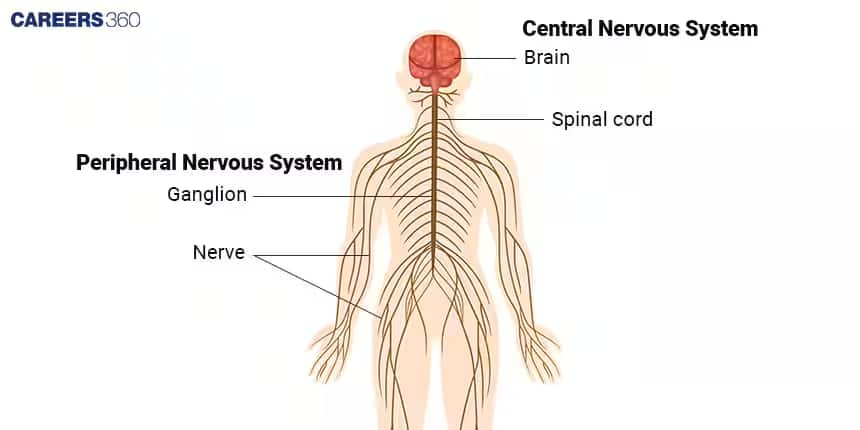
Neuron: Structural and Functional Unit
A neuron consists of three parts:
Part | Description |
Cell Body | Contains cytoplasm, organelles, and Nissl’s granules (absent in axons). |
Dendrites | Short fibers branching from the cell body; they contain Nissl’s granules. |
Axon | Long fiber ending in synaptic knobs; may be myelinated or unmyelinated. |
Types of Neurons
The types of neurons based on structure are given below:
Multipolar: One axon, multiple dendrites (e.g., cerebral cortex).
Bipolar: One axon, one dendrite (e.g., retina).
Unipolar: Only one axon present (found in embryos).
Axon Types:
The types of axons are:
Myelinated Axons:
Covered with a myelin sheath formed by Schwann cells.
Found in the spinal cord and cranial nerves.
Gaps between myelin sheaths are called Nodes of Ranvier.
Unmyelinated Axons:
No myelin sheath; found in autonomic and somatic systems.
Diagram: Structure of a Neuron

Generation and Conduction of Nerve Impulse
The stage and process of a nerve impulse can be discussed in the table given below:
Stage | Process |
Resting State | - Membrane permeable to K+ but impermeable to Na+ |
- Sodium-potassium pump maintains ionic gradient (+ outside, −inside). | |
- The potential difference across the membrane is called the resting potential. | |
Stimulus Response | - Membrane becomes permeable to Na+, reversing charges (−outside, + inside). |
- This creates an action potential or nerve impulse. | |
- Impulse travels through repeated depolarization/repolarization cycles along the neuron. |
Diagram: Generation of Nerve Impulse
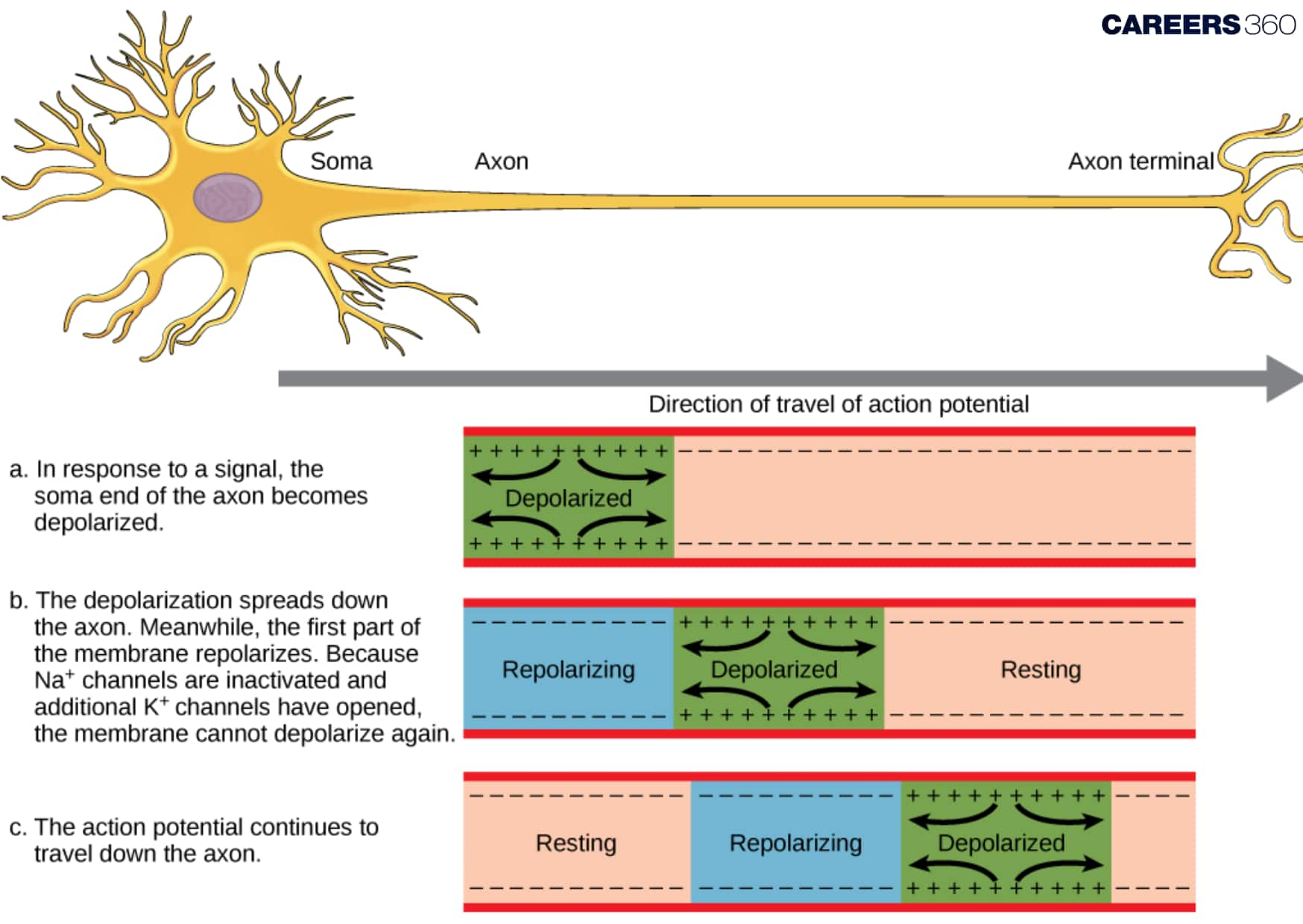
Central Neural System (CNS)
The CNS includes the brain and spinal cord.
Brain:
Protected by the skull and covered by three layers called cranial meninges:
Dura mater
Arachnoid
Pia mater
Divisions of the Brain:
The divisions of the brain are as follows
Diagram: Divisions of the Brain
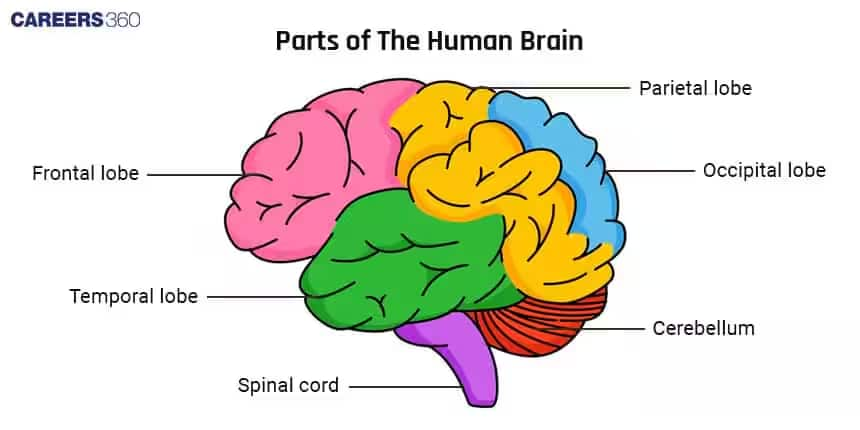
Forebrain
- The Forebrain includes the cerebrum, thalamus, and hypothalamus.
Functions:
Cerebrum: Memory, sensory processing.
Thalamus: Sensory relay center.
Hypothalamus: Regulates temperature, hunger, and thirst.
Structure of Forebrain:

Midbrain
Connects the forebrain to the hindbrain.
The Midbrain contains the corpora quadrigemina for visual/auditory reflexes.
Structure of the Midbrain:
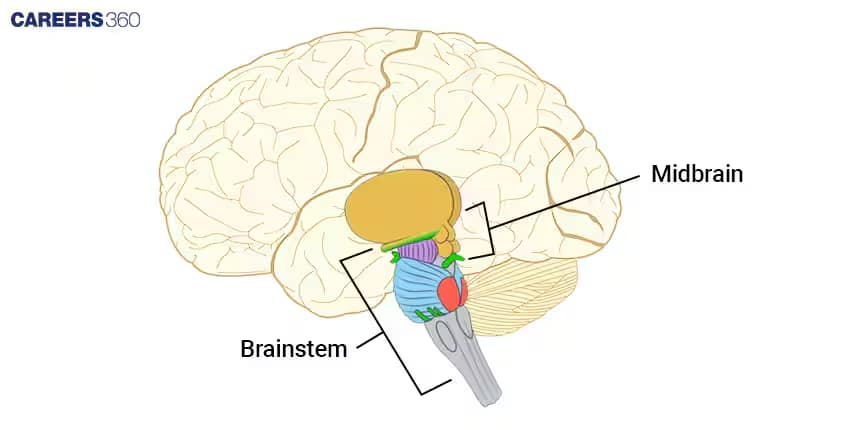
Hindbrain
Hindbrain includes the pons, cerebellum, and medulla oblongata.
Functions:
Pons: Relays signals between brain regions.
Cerebellum: Maintains posture/balance.
Medulla oblongata: Controls heart rate and breathing.
Structure of Hindbrain:
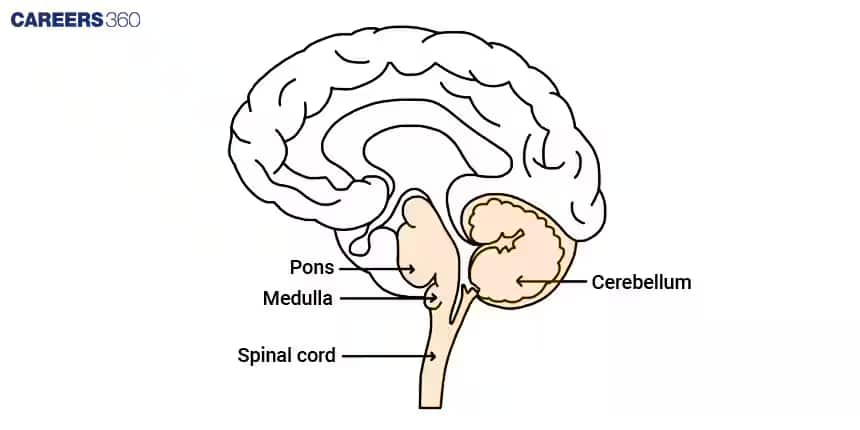
Reflex Action and Reflex Arc
Reflex action is an involuntary response to a stimulus.
Components of a reflex arc:
Receptor
Sensory neuron
CNS (spinal cord)
Motor neuron
Effector
Diagram: Reflex Arc

Also, Read
Chapter 18 Biology: Previous Year Questions and Answers
Some previous year questions given below help students get familiar with the exam format and test their level of preparation. For conceptual clarity, students can use the NCERT Class 11 Biology Chapter 18 Notes Neural Control and Coordination.
Question 1: Which of the following is not involved in the Knee reflex?
Option 1. Muscle spindle
Option 2. Motor neuron
Option 3. Brain
Option 4. Inter neurons
Answer:
An automatic response channel that does not directly engage the brain is known as the reflex arc. It consists of parts, including motor neurons, which send signals to muscles for contraction, interneurons, which let sensory and motor neurons in the spinal cord communicate, and muscle spindles, which sense changes in muscle length.
Hence, the correct answer is option (3) Brain
Question 2: Resting membrane potential is maintained by
Option 1. Hormones
Option 2. Neurotransmitters
Option 3. Ion pumps
Option 4. None of the above
Answer:
The sodium-potassium pump and leak channels are examples of ion pumps and channels that preserve a cell's resting membrane potential:
Potassium-sodium pump
For every ATP molecule, this pump transports two potassium ions into the cell and three sodium ions out of it. The potassium ion concentration gradient produced by this action adds to the resting membrane potential.
Hence, the correct answer is option (3): Ion pumps.
Question 3: The Potential difference across the resting membrane is negatively charged. This is due to the differential distribution of the following ions.
Option 1. Na+ and K+ ions
Option 2. CO32-and Cl- ions
Option 3. Ca2+ and Mg2+ ions
Option 4. Ca2+ and Cl- ions
Answer:
The potential difference across the resting membrane is negative. This is due to the differential distribution of Na+ and K+ ions. The electrical charge differential across a cell membrane caused by the combined forces of ions and their permeability is known as the membrane potential. It is essential for both cellular communication and general bodily processes.
Hence, the correct answer is option (1) Na+ and K+ ions.
Question 4: Which part of the brain maintains the posture and balance of the body?
Option 1. Cerebrum
Option 2. Medulla oblongata
Option 3. Cerebellum
Option 4. Pons
Answer:
The cerebellum is responsible for maintaining posture, balance, and coordination of voluntary movements. It receives sensory information from muscles, joints, and the inner ear and fine-tunes motor activity to ensure smooth and precise movements.
Hence, the correct answer is option (3) Cerebellum.
Question 5: The neurotransmitter released at the neuromuscular junction is
Option 1. Dopamine
Option 2. Acetylcholine
Option 3. Noradrenaline
Option 4. Serotonin
Answer:
At the neuromuscular junction, acetylcholine is released from the synaptic vesicles of the motor neuron. It binds to receptors on the muscle fiber membrane, causing depolarisation and initiating muscle contraction.
Hence, the correct answer is option (2) Acetylcholine.
Also Read:
How to Use Neural Control And Coordination Class 11 Notes Effectively?
The nervous system helps organisms respond to internal and external changes through quick coordination. Understanding these processes requires clear concepts and regular practice.
Go through labelled diagrams of the human brain, spinal cord, and neurons for quick visual memory.
Revise the functions of the central and peripheral nervous systems with the help of Class 11 Biology Chapter 18 Neural Control And Coordination Notes PDF.
Practice flowcharts explaining reflex action, nerve impulse transmission, and synaptic conduction.
Use the Neural Control and Coordination Class 11 Notes to focus on important terms like axon, synapse, neurotransmitters, and sense organs.
Solve previous years’ questions to get familiar with the types of questions asked and their difficulty level.
Advantages of Class 11 Biology Chapter 18 Neural Control And Coordination Notes
The working of the brain is important to understand how the nervous system functions and coordinate the activities of the human body. Going through the well-organised notes makes it easier for students to structure of the spinal cord and the neurons.
- Class 11 Biology Chapter 18 Neural Control and Coordination Notes PDF simplifies difficult concepts like impulse generation, transmission, and synaptic conduction.
- The structure and function of the forebrain, midbrain, and hindbrain are explained clearly, along with the diagrams.
- Students can improve their visual memory and better retention of concepts by using the notes on a regular basis.
- Important terms and definitions are highlighted in an easy-to-remember manner to save time during boards and competitive exams like NEET.
Chapter-Wise NCERT Class 11 Notes Biology
The chapter-wise notes are given below, by which students can easily access all the chapters and start practicing to score well in the exam.
Frequently Asked Questions (FAQs)
A synapse is the junction between neurons where neurotransmitters transfer impulses, ensuring unidirectional signal transmission.
A reflex action is a rapid, involuntary response mediated by the spinal cord without brain involvement, using a reflex arc (sensory → spinal cord → motor neuron).
Types include sensory neurons (carry impulses to CNS), motor neurons (transmit signals from CNS to organs), and interneurons (relay signals within CNS).
Neural control refers to the nervous system’s regulation of body activities through electrical impulses, while coordination ensures organs work together harmoniously, as explained in the NCERT Class 11 Biology Chapter 18 Notes Neural Control and Coordination. For example, withdrawing a hand from fire involves rapid neural signaling
CNS processes information (brain/spinal cord), while PNS transmits signals between CNS and body parts via afferent (to CNS) and efferent (from CNS) nerves. For a detailed comparison, students can refer to the NCERT Class 11 Biology Chapter 18 Notes Neural Control and Coordination.
The components are the Central Nervous System (CNS) and Peripheral Nervous System (PNS). CNS includes the brain and spinal cord, while PNS consists of nerves connecting CNS to organs.
Neurons transmit electrical signals (action potentials) via depolarization. At synapses, neurotransmitters carry signals to the next neuron.
The brain processes sensory input, controls voluntary movements and homeostasis, and regulates emotions, memory, and endocrine functions.
Popular Questions
Courses After 12th
Applications for Admissions are open.
As per latest syllabus. Physics formulas, equations, & laws of class 11 & 12th chapters
JEE Main Important Chemistry formulas
Get nowAs per latest syllabus. Chemistry formulas, equations, & laws of class 11 & 12th chapters
JEE Main high scoring chapters and topics
Get nowAs per latest 2024 syllabus. Study 40% syllabus and score upto 100% marks in JEE
JEE Main Important Mathematics Formulas
Get nowAs per latest syllabus. Maths formulas, equations, & theorems of class 11 & 12th chapters
